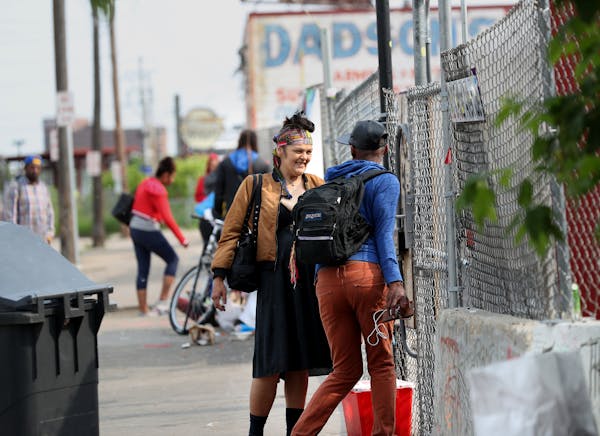A proposal that would give police authority to shut down tent encampments has run into opposition from Hennepin County and Minneapolis leaders, who favor a more collaborative approach.
Five days after the closure of a temporary shelter for residents of last year's massive Hiawatha encampment, officials are still working on a uniform response protocol as homeless people set up new tents across the city.
Under a draft proposal by Heading Home Hennepin, a collaboration of city, county and community organizations, police would "act as the central point of contact" when a new homeless encampment emerges to assess its threat to public safety. Officers would work alongside property owners and community advocates, but they would dictate how long encampments can remain.
"If risks increase significantly, expedited removal may be required," according to the proposal. "There may also be instances where risks are reduced and other factors come to light (an imminent housing placement) that lead to agreement on additional time."
City and county officials say they're concerned that a law enforcement-first approach would stoke tension among homeless residents, put them at risk of jail and ultimately make it more difficult for people to transition into shelter.
"There's a lot of discomfort with the Heading Home Hennepin protocol," said Minneapolis City Coordinator Nuria Rivera-Vandermyde, emphasizing the draft is unfinished. "I think it's too law-enforcement centered."
The proposal comes after hundreds of people raised an encampment that dotted Franklin and Hiawatha avenues with tents last fall, bringing attention to the city's growing unsheltered population. That encampment, known as the Wall of Forgotten Natives, created controversy in the Twin Cities because of its size and potential dangers for drug overdoses, fire hazards, theft and fights.
In response, as winter moved in, Minneapolis city officials and partners including Simpson Housing Services and Red Lake Nation set up a Navigation Center that sheltered 176 people and connected them to housing and other services.
The center closed Monday, and warmer weather has prompted a visible uptick in pitched tents along streets and freeways as more homeless people sleep outside because of a lack of shelter beds or to avoid the confines and regulations of the facilities.
The Heading Home Hennepin proposal cites risk factors that would determine how quickly an encampment is disbanded. That would include if women, children, older adults or disabled people were there; proximity to traffic; fires or used needles in the area; extreme hot or cold weather, and criminal activity such as sex trafficking or violence.
Not allowing public safety officers to have a role in dealing with encampments would be "selling ourselves short and not taking advantage of helping people as much as we can," said Minneapolis police Sgt. Grant Snyder, part of the department's homelessness and vulnerable populations initiative. He pointed out that officers are often the first ones to get the calls about tents with homeless people, be it on the street or in someone's backyard.
He said officers have been working to be mindful of the vulnerable populations they come across and build trust with them. Bringing an "open hand" approach — along with items like gloves, socks and water — has helped officers foster better communication with homeless residents and avoid use of force.
"Obviously we're all better off with people not sleeping outside, and it affects all of us," Snyder said. "We want to try and provide as many services as we can."
David Hewitt, director of Hennepin County's Office to End Homelessness, said the document is still in draft stage, and the language about law enforcement's autonomy "does need further work."
"I don't think any of us want to create additional barriers to people wanting to exit homelessness and into housing," Hewitt said.
Hennepin County Commissioner Angela Conley said she's concerned about potential harm against a vulnerable population that is often dealing with substance abuse and untreated mental illnesses or simply has no place to go. She said with blacks and American Indians making up a majority of Minneapolis' homeless population, there's a risk for racial profiling. It's also hard to build trust with unsheltered residents if there's an armed officer nearby.
"If we have outreach workers that go out there and there's illegal activity or someone's life is in danger … there's multiple reasons why a police response would be necessary, but if it's just a group of tents where that's the only place they have to sleep then that's not a public safety threat," Conley said.
Advocates and community members often point to local shelters as a place for refuge but homeless residents say they feel unsafe there or do not want to follow prohibitions against pets or bringing in spouses. There's also no guarantee a bed is always available.
Lack of shelter beds is "just a reality" elected officials will have to manage beyond unsheltered encampments, said Minneapolis City Council President Lisa Bender. She said the draft protocol's law enforcement guidance is "so far away from really reflecting" officials' current and future response to encampments.
Bender said health, fire, police and public works officials should collectively decide how to respond to unsheltered homelessness. She said officers like Snyder have been exemplary in their actions, and others should follow their lead in building relationships with the homeless community.
However, "we can't write down on a piece of paper 'Minneapolis Police Department' and assume we mean this one particular staff person who has great relationships with the community," Bender said.
marissa.evans@startribune.com • 612-673-4280 andy.mannix@startribune.com • 612-673-4036
Searching for Snoopy: What happened to all the 'Peanuts' statues in St. Paul?
North Oaks withdraws request for density exemption from Met Council

Fall or spring, it's Rochester Mayo's year in prep tennis

Minneapolis reaches $150k settlement with eyewitness of George Floyd's murder

